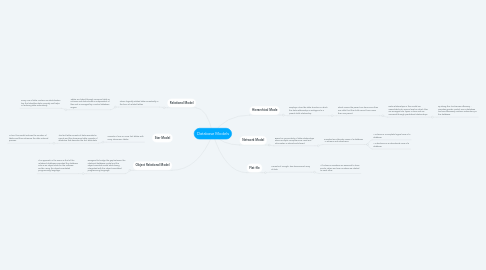
1. Relational Model
1.1. Stores logically related data consistently in the form of related tables
1.1.1. Tables are linked through common fields or columns and data stored is independent of files and is managed by a central database engine
1.1.1.1. Every row of data contains an identification key that identifies data uniquely and helps in reducing data redundancy.
2. Star Model
2.1. Consists of one or more fact tables with many dimension tables
2.1.1. The fact table consists of data recorded in events and the dimension table consists of attributes that describe the fact table data
2.1.1.1. In turn this model reduces the number of tables and thus enhances the data retrieval process.
3. Object Relational Model
3.1. Designed to bridge the gap between the relational database model and the object-oriented model while being integrated with the object-orientated programming language
3.1.1. The approach is the same as that of the relational databases provided the database acts as an object store for the software written using the object-orientated programming language.
4. Hierarchical Mode
4.1. Employs a tree-like data structure in which the data relationship is analogous to a parent-child relationship
4.1.1. which means the parent can have more than one child, but the child cannot have more than one parent.
4.1.1.1. Data relationships in this model are assimilated into various levels in which files are arranged into layers or tiers and are accessed through predefined relationships
4.1.1.1.1. By doing this it enhances efficiency , provides greater control over a database and simultaneously reduces redundancy in the database.
5. Network Model
5.1. Based on connectivity of data relationships where multiple computers are used and information is stored and shared.
5.1.1. Provides two alternate views of a database - a schema and subschema
5.1.1.1. A schema is a complete logical view of a database
5.1.1.2. A subschema is a subordinate view of a database
6. Flat file
6.1. Consists of a single, two dimensional array of data
6.1.1. All columns members are assumed to have similar values and row numbers are related to each other

